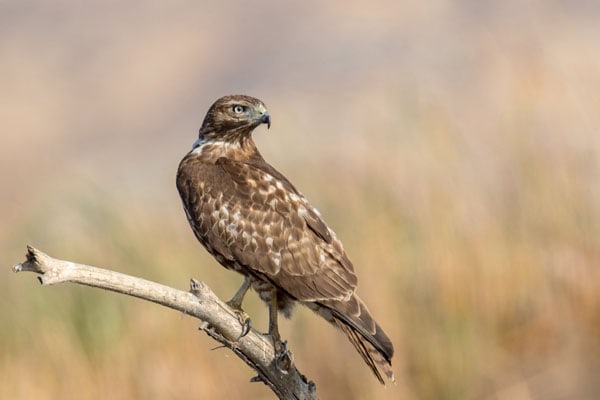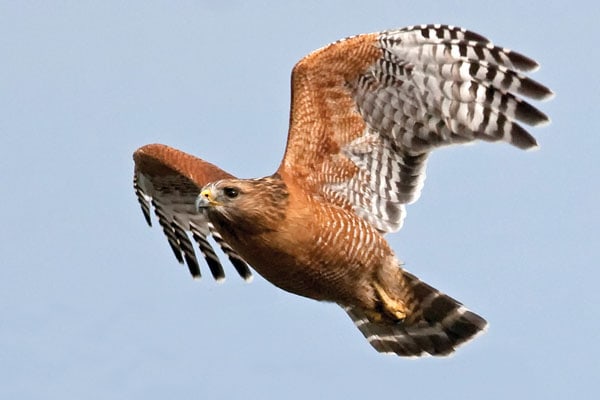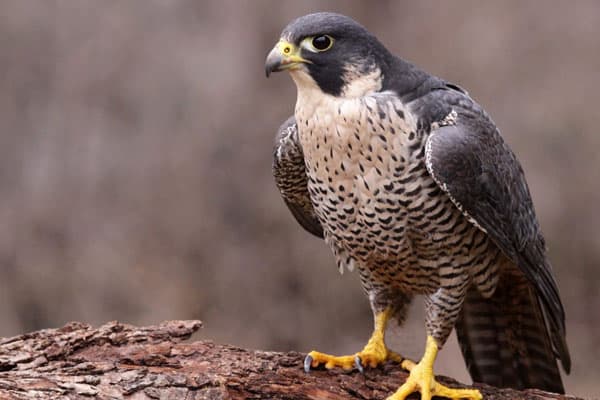Did you know that Georgia is home to a remarkable variety of hawks? These majestic birds of prey not only grace the skies with their awe-inspiring presence but also play a vital role in maintaining the ecological balance of the state. From the impressive red-tailed hawk to the elusive northern harrier, Georgia offers a diverse haven for these aerial hunters. Join us as we delve into the world of hawks in Georgia, uncovering their fascinating species and unique habits.
Main Points:
- Georgia is home to a remarkable variety of hawks
- Hawks play a vital role in maintaining the ecological balance
- Red-tailed hawk, red-shouldered hawk, broad-winged hawk, sharp-shinned hawk, Cooper’s hawk, and northern harrier are some of the species found in Georgia
- The presence of hawks in Georgia highlights the region’s rich avian life and diverse ecosystems
- Exploring the characteristics and behaviors of hawks offers a deeper understanding of their significance and impact
1. Red-Tailed Hawk
One of the most prominent hawk species in Georgia is the red-tailed hawk. These majestic birds are known for their large size and distinct red tail feathers, which give them their name. Red-tailed hawks are a common sight throughout the state and can be found in a variety of habitats, including forests, open fields, and even suburban areas.

Red-tailed hawks are skilled hunters and primarily feed on small mammals, such as rodents and rabbits. They have sharp talons and a keen eyesight that allows them to spot their prey from high perches or while soaring through the sky. When hunting, these hawks will often perch on tree branches or telephone poles, patiently waiting for the perfect moment to dive down and catch their next meal.
“The red-tailed hawk is truly a magnificent bird of prey, with its impressive wingspan and piercing gaze. It is a true symbol of the wilderness and natural beauty found in Georgia.”
Georgia provides an ideal habitat for red-tailed hawks, as the state offers a diverse range of landscapes and abundant prey. These hawks are known to build their nests high up in trees or on cliffs, using sticks and twigs to create a sturdy foundation. They are monogamous birds and typically mate for life.
Habitat and Behavior
Red-tailed hawks are adaptable birds and can be found in a variety of habitats, including forests, grasslands, and deserts. They are known for their ability to soar effortlessly through the sky, using thermal updrafts to gain altitude while conserving energy. These hawks are also skilled at catching rising air currents, which allows them to cover long distances during migration.
During breeding season, red-tailed hawks perform elaborate courtship displays, where they engage in aerial acrobatics and call out to attract a mate. Once a pair has formed, they will work together to build a nest and raise their young. Red-tailed hawks are attentive parents, providing food and protection to their offspring until they are old enough to leave the nest.
Interesting Facts
Here are some fascinating facts about red-tailed hawks in Georgia:
| Fact | Description |
|---|---|
| Size | Red-tailed hawks can reach a wingspan of up to 4 feet and weigh between 2-4 pounds. |
| Migratory Patterns | Some red-tailed hawks in Georgia are migratory, while others are year-round residents. |
| Hunting Techniques | These hawks often use a hunting strategy called “stooping,” where they dive down from great heights to catch their prey. |
| Conservation Status | Red-tailed hawks are not currently listed as endangered or threatened, but habitat loss and human activities can impact their populations. |
By understanding the characteristics and behaviors of red-tailed hawks, we can develop a deeper appreciation for these magnificent birds and the important role they play in Georgia’s ecosystems.
2. Red-Shouldered Hawk
The red-shouldered hawk is a remarkable species that calls Georgia home. With its distinct features and fascinating behaviors, this hawk has become a significant presence in the state’s ecosystems.
Characterized by its reddish-brown shoulders and barred underparts, the red-shouldered hawk is easily recognized. It boasts a wingspan of around three feet, making it a medium-sized hawk species. Their striking appearance and piercing calls make them a delight to spot and hear while exploring Georgia’s wildlife-rich areas.

This hawk species is most commonly found in forested areas, particularly near wetlands and rivers. The red-shouldered hawk prefers to nest high up in trees, constructing large nests made of sticks and lined with softer materials such as moss and other vegetation. These nests are often reused year after year, with new layers added to accommodate growing families.
When it comes to hunting, the red-shouldered hawk is known for its patience and precision. They primarily feed on small mammals, amphibians, reptiles, and occasionally birds. Their keen eyesight allows them to spot potential prey from a great distance, and once a target is located, they swoop down with impressive speed and agility to capture their meal.
The red-shouldered hawk plays a vital role in the ecosystems of Georgia. By controlling populations of rodents and other small animals, they help maintain a balanced prey-predator relationship. Additionally, their presence in the state is a testament to the rich biodiversity that Georgia offers.
3. Broad-Winged Hawk
The Broad-Winged Hawk is a captivating species that can be found soaring through the Georgia skies. With its distinctive appearance and mesmerizing flight patterns, this hawk leaves an indelible impression on anyone fortunate enough to spot it.
One of the remarkable physical characteristics of the Broad-Winged Hawk is its broad wingspan, which often spans over three feet. This feature allows the bird to effortlessly glide through the air, showcasing its graceful and agile nature. Its plumage generally consists of rich browns and dark bands, blending seamlessly with the surrounding forested landscapes.
When it comes to habitat preferences, the Broad-Winged Hawk tends to favor wooded areas with dense vegetation. It particularly thrives in deciduous forests and mature woodlands, where it can take advantage of the ample cover and abundant prey. This intelligent predator showcases its hunting prowess by swiftly swooping down on small rodents, amphibians, and reptiles.

It is important to note that the Broad-Winged Hawk is a migratory species that embarks on incredible journeys. It undertakes long-distance migrations, traveling from its breeding grounds in Canada and the northeastern United States to its wintering grounds in Central and South America. These awe-inspiring journeys involve crossing vast distances, including the Gulf of Mexico, as the hawks make their way to their temporary homes.
“The Broad-Winged Hawk’s migratory patterns demonstrate its incredible adaptability and resilience as it navigates across different landscapes and climates.”
Within the ecosystem, the Broad-Winged Hawk plays a crucial role in maintaining the balance of nature. As an apex predator, it helps regulate populations of small mammals and reptiles, preventing their overabundance. Its presence also serves as an indicator of the health and diversity of the surrounding habitat.
To catch a glimpse of the Broad-Winged Hawk in Georgia is a truly special experience. Witnessing its majestic flight and witnessing its unique adaptations reminds us of the diverse and awe-inspiring beauty found in the state’s avian world.
Sharp-Shinned Hawk and Cooper’s Hawk
When it comes to the world of hawks in Georgia, the spotlight is often on the larger species like the red-tailed hawk and the red-shouldered hawk. However, there are two smaller hawk species that are just as fascinating: the Sharp-Shinned Hawk and the Cooper’s Hawk.
The Sharp-Shinned Hawk (Accipiter striatus) and the Cooper’s Hawk (Accipiter cooperii) are both members of the Accipiter genus, known for their agility, speed, and sharp talons. While these two hawks may share some similarities, they also have distinct characteristics that set them apart.
4. Sharp-Shinned Hawk
The Sharp-Shinned Hawk is the smaller of the two, measuring around 10-14 inches in length with a wingspan of about 20-26 inches. They have a compact body, short neck, and long, narrow wings that enable them to maneuver through dense vegetation with ease.
One distinguishing feature of the Sharp-Shinned Hawk is its long, banded tail. Their plumage varies depending on their age and sex. Adult females have a dark brown back with a fine, rusty barring on their breast, while adult males have a slate-gray back with a darker head and reddish barring on their breast.
Sharp-Shinned Hawks primarily feed on small songbirds, such as sparrows and finches. They are known for their stealthy hunting technique, which involves flying low and fast through trees to surprise their prey. They are incredibly agile and can make sharp turns and quick dashes to catch their target.
5. Cooper’s Hawk
The Cooper’s Hawk is slightly larger than the Sharp-Shinned Hawk, measuring around 14-18 inches in length with a wingspan of about 24-35 inches. They have a rounded tail and broad, rounded wings, which aid in their rapid flight and maneuverability.
Similar to the Sharp-Shinned Hawk, the plumage of the Cooper’s Hawk varies depending on age and sex. Adult females have a dark brown back with thick, dark barring on their breast, while adult males have a slate-gray back with a lighter breast and finer barring.
Cooper’s Hawks primarily prey on medium-sized birds, such as doves and pigeons. They are known for their impressive aerial displays, often chasing their prey through trees and maneuvering with great skill. Their hunting strategy involves surprising their prey with sudden bursts of speed, using their long legs and sharp talons to catch them.
Both the Sharp-Shinned Hawk and the Cooper’s Hawk are skilled hunters, playing vital roles in regulating bird populations and maintaining balance within the ecosystem.
“These smaller hawk species may not always steal the spotlight, but their agility and hunting prowess are truly remarkable.” – Birdwatching Enthusiast
6. Northern Harrier
Let’s now turn our attention to the fascinating northern harrier, a striking hawk species that calls Georgia its home. These magnificent birds possess a range of unique characteristics and play a vital role in the state’s ecosystems.
The northern harrier, also known as the marsh hawk, is easily identifiable by its distinctive flight style and physical appearance. With narrow wings that feature a white rump patch, they soar gracefully above marshes and grasslands, hunting for small mammals and birds.
Hunting Strategies of the Northern Harrier
What sets the northern harrier apart from other hawks is its predatory techniques. These intelligent hunters rely on their excellent hearing to locate prey concealed in thick vegetation. Once a potential target is detected, the harrier executes a low, gliding approach, barely making a sound. This stealthy tactic gives it a significant advantage over its unsuspecting victims.
The northern harrier’s ability to fly low and slow, combined with its exceptional hearing, makes it a masterful hunter in Georgia’s wetlands and grasslands.
Additionally, the northern harrier employs a unique behavior known as “sky-dancing”. During courtship displays, the male harrier spirals and soars high into the air while performing elaborate aerial acrobatics. This elegant spectacle is not only mesmerizing to witness but also serves as a means of attracting potential mates.
The Role of Northern Harriers in Georgia’s Ecosystems
The presence of northern harriers in Georgia has significant ecological implications. As top predators, they help regulate populations of small mammals such as mice, voles, and rabbits. By keeping these populations in check, harriers contribute to the overall balance and health of their habitats.
Furthermore, the hunting behavior of northern harriers can benefit farmers and agricultural communities. Their preference for rodents helps control pest populations, reducing crop damage and promoting sustainable farming practices.
In Summary
The northern harrier, with its distinct physical traits and unique hunting strategies, offers a captivating glimpse into the world of hawks in Georgia. It plays a crucial role in maintaining the delicate balance of ecosystems by controlling prey populations and supporting local agriculture. As we continue our exploration of hawks in Georgia, let’s now turn our attention to the fascinating world of falcons in the next section.
Falcons in Georgia
As you continue exploring the fascinating world of hawks in Georgia, it’s impossible to overlook the presence of falcons in the state. Falcons, like hawks, are powerful and agile birds of prey that captivate birdwatchers and nature enthusiasts alike.

Georgia is home to several falcon species, each with its own unique characteristics and hunting techniques. One notable falcon species found in the state is the peregrine falcon. Known for its incredible speed and aerial acrobatics, the peregrine falcon is a true marvel of nature. These majestic birds can be seen soaring through the skies, hunting their prey with remarkable precision, and leaving awe-inspiring sights for those lucky enough to witness their flights.
Another falcon species commonly found in Georgia is the American kestrel. These small but mighty birds are known for their colorful plumage and hovering hunting technique. American kestrels can often be spotted perched on wires or fence posts in open fields, searching for insects, small mammals, and other prey.
The presence of falcons in Georgia brings a unique dynamic to the avian ecosystem. While hawks and falcons share similar habitats, their hunting strategies differ. Falcons, with their exceptional speed and agility, are often referred to as the “fighter jets” of the bird world. They rely on their incredible speed and maneuverability to hunt birds in mid-air, making them fierce competitors in the skies.
Just like hawks, falcons play a crucial role in maintaining the ecological balance in Georgia. Their predation on smaller birds helps regulate populations and ensure the overall health of the ecosystem.
As you explore the diverse birdlife in Georgia, take a moment to appreciate the presence of falcons alongside hawks. These magnificent birds are a testament to the beauty and complexity of nature, reminding us of the intricate interconnections that exist in the natural world.
Check Our Previous Articles:
Final Thoughts…
Congratulations on reaching the end of our exploration of hawks in Georgia! Throughout this article, we have covered a wide range of fascinating information about these majestic birds and their significance in the state’s ecosystems.
What is the most common hawk in Georgia? While each species contributes to the state’s avian tapestry, the red-tailed hawk stands out as one of the most frequently spotted hawks. With its distinct red tail feathers and piercing gaze, this hawk is a sight to behold.
Furthermore, if you’re hoping to encounter some large hawks in Georgia, keep an eye out for the broad-winged hawk. This sizeable hawk species is known for its broad wings and migratory patterns, providing nature enthusiasts with awe-inspiring spectacles as they traverse the state.


Add comment